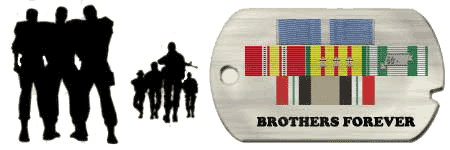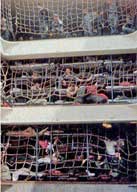84th Engineer Battalion (Construction) Vietnam
Qui Nhon - Operation Duke - Da Nang - Phu Bai - LZ Baldy
This website represents the Memories of those Men who served with the 84th in the Republic of Vietnam

For those who fought for it Freedom has a flavor the protected will never know
Article from the Vietnam Magazine dated April 2003.
The 35th Engineer group arrived in Vietnam
after a lengthy and delayed odyssey by sea.
by Philip Katcher
Some U.S. Army troops can boast more sea time than some of their colleagues who served in the Navy and Coast Guard. Among these were the men of the 35th Engineer Group (Construction), sent to prepare the way for the huge buildup of American Forces in Vietnam in early 1965. The men of that unit spent almost a month at sea on their way to a war others would reach in some 20 hours of flying.
At the end of 1964, President Lyndon B. Johnson decided to commit ground troops to the fight against the VC and the North Vietnamese Army. He ordered his commanders to have significant infantry forces in that country by mid 1965. Among the logistic factors the Army brass had to consider were landing several divisions and, no less important, supplying them in a Third World country. Vietnam is blessed with several beautiful and spacious bays, especially in Cam Rahn and Qui Nhon, but the pot facilities were limited at best.
Major General T.J. Hayes III, who served with the Corps of Engineers in Vietnam, later wrote: "The increased strength and rapid deployment of American troops in Vietnam created a soaring requirement for logistics and air support. Military air facilities and port facilities at Saigon are particularly needed. But even if the Port of Saigon could handle the supplies, their distribution would be difficult. Most of the highways in the country are controlled by the Viet Cong, have been cut, or are under harassment by guerillas much of the time.
Thus, the Army decided to send an Army Engineer Construction Group to the country to enlarge those port facilities beyond and build airfields in the areas as well. The first military unit picked for the job was the 35th Engineer Group, commanded by Colonel Philip F. Hart Jr. The group was based in Fort Polk La., and consisted of the 46th Engineer Battalion (Construction), and the 168th Engineer Battalion (Combat) and an independent construction company. Those two battalions, however, did not accompany the group headquarters but would be sent to Vietnam later. Instead, the group was assigned two other battalions, the 84th Engineer Battalion (Construction), stationed in Fort Ord, Calif., and the 864th Engineer Battalion (Construction), stationed in Fort Wolters, Texas.
The 84th and 864th were notified in early April 1965 that they had one month to get their equipment all packed, bring their men medically up to date and report to Oakland, Calif., where they would board a troop ship. Their destination was kept secret from the rank and file --- travel orders did not mention the actual destination, although most soon figured out where they were going.
Many of those slated to accompany the unit had never even qualified with the M-14 rifle. They were told they would receive weapons training and qualification on board the troopship. For one reason or another, however, that never happened.
In early May the 864th headed by train to California. Lieutenant Colonel James E. Bunch and a small advance party left earlier by air to set up the new cantonment area at Cam Rahn Bay, the units destination. In Oakland the 864th's main body was joined by Headquarters and Headquarters Company, 35th Engineer Group; the 84th Engineer Battalion; the 513th Engineer Company (Dump Truck; the 584th Engineer Company (Light Equipment); the 178th Engineer Company (Maintenance); and the 53rd Engineer Company (Supply Point)for what was supposed to be a 17 day sea voyage to Vietnam.
As Headquarters Company of the 864th marched up the dock toward USNS Eltinge, one older master sergeant exclaimed: "I know that boat. I went to France on her in 1945." Once on board, the men heard sailors taking bets on whether or not the ship survives the trip across the Pacific. Eltinge was an old World War II Liberty Ship that had been taken out of mothballs only days before. Although shipyard workers had spent many man-hours preparing her for the trip, she turned out not to be ready for the task.
On May 13, Eltinge pulled out of Oakland, passing under a Golden Gate bridge whose tops were hidden by the fog. Life aboard the old ship was no fun, especially for the bored enlisted men. They slept in berths stacked five high. The mess hall was reached by going down one flight of stairs and up another half flight. Standing in the slow moving line, the men watched the water on the mess hall deck, carrying bits of food, slowly moving from side to side as the ship rocked. Many men ended up dashing outside before even getting into the hall, their stomachs recoiling.
Once in the mess hall, one got a tray of food and then went to a series of ironing board like tables to stand and eat, as NCOs hurried the meals along. NCOs barked out orders for the man at the end of the table to leave the second his meal was finished, to let newcomers in. "Eat it and beat it," the men recalled the experience. Between meals, the main activities involve standing near bow of the ship to watch flying fish spin out of Eltinge's way.
Headquarters Company, 864th Battalion, held only one formation on deck during the trip. At that gathering, the company commander, Captain T.E. Dawson, announced that where they were going was still officially secret, but that everyone would collect hazardous duty pay while there. That pretty much confirmed in everyone's minds that they were bound for Vietnam.
Since the trip was supposed to be short, the ship had no facilities for laundry or even showers. Eltinge was due to arrive in Vietnam on May 30. But sailors had to work daily on different components of the ship as they broke down. Halfway across the Pacific, multiple pump failures occurred, and the sailors were unable to get the ship moving under its own power again.
For two days, Eltinge drifted on a fortunately smooth Pacific Ocean. Had a storm arisen, the ship would have been in great danger, unable to maneuver. During the day, she moved sideways in the water. Her super structure forming a giant metal sail. Because she lacked power, hot meals were impossible, and only cold cuts and sandwiches were served. The decks below were lit by emergency lights, but the heat became intense because fans were no longer working. Some men began sleeping on the decks.
On the third day adrift, another Navy ship drew alongside Eltinge and secured her by lines. Loudspeakers blared out orders that no photographs were allowed. Naturally, every soldier who had a camera dashed below to retrieve it from his duffle bag, and MPs dashed around the decks, grabbing cameras, removing film and throwing it overboard before returning the camera's. Still, a number of soldiers did manage to get photos home of this "secret ship," later rumored to be a nuclear-powered icebreaker.
The rescue ship towed Eltinge to the nearest U.S. port, at Midway Atoll, some 500 miles away. There, men and cargo were transferred to a newer ship. SNSN Barrett. While port workers transferred both Army equipment and the troops personal luggage, the men were allowed on shore. The officers, who had had a chance to shower on shipboard, were allowed to visit the officers club, the base exchange and other sites on the island. The dirty troops were not allowed in the few built up areas. Instead, they explored the shoreline, with its bunkers from 1941 that were now filling with sand. The 864th Headquarters Company did hold one beer party ashore during the layover. The men coming back that evening to their bunks on Eltinge were checked by MPs on the gangway for smuggled beer bottles.
 All dressed up and no place to go:Members of the 35th Engineer Group (Construction)
All dressed up and no place to go:Members of the 35th Engineer Group (Construction)
peer from their crowded quarters aboard the transport Barrett , still waiting to reach South Vietnam
(Courtesey of Phillip Katcher)
After several days, everything was off Eltinge and on Barrett. The new ship pulled out of Midway, and the 35th's odyssey was under way again. Barrett went first to the Philippines, where the officers were allowed liberty and the men had to remain on board. Most watched through the rope rigging that separated the berths from the ships open holds as dozens of barefoot, scrawny Filipinos came into the holds to load cargo onto rope nets to be hoisted away. The men looked on with some amusement as the work crew accidentally smashed a timber through the front and rear windows of a new, expensive American car, likely the property of some officer who was stationed in Manila.
Within a day, Barrett set sail again, around the island to the U.S. Navy base at Subic Bay. There, she spent several days while more cargo was unloaded. Since this was a fenced-in, secure Navy base, everyone was allowed to leave the ship. Officers and men shopped at the giant base exchange and ate at restaurants --- their first good food in nearly a month. For many it was also their first glance at Asian life, its dirt poor villages and verdant hillsides and forests.
The officers didn't have much time for sightseeing, as the commander of the advance party, a Lt. Col. Haskins, had taken advantage of the delay to fly to Subic Bay to brief Colonel Hart and the other commanders. Haskins then immediately boarded a plane back to Saigon.
After a couple of days, Barrett steamed off for Vietnam. The prolonged voyage had already compressed the schedule for getting facilities built before the fall monsoon season. Moreover, it had taken its toll on the troops morale. Two men attempted suicide while on board. The rest soldiered on.
Finally, on June 9, almost a month after they left Oakland, the officers and men of the 35th Engineer Group saw the coastline of Vietnam. They arrived in the harbor of Cam Rahn Bay, and most of the group's main body disembarked onto bright yellow sandy beaches under cloudy skies. Recalled Captain Lindbergh Jones, public information officer for the 35th: "As the troops began to unload on the day of their arrival, it began to rain heavily.... [But] it was the dry season, and very little precipitation could be expected in the months ahead."
The 84th Engineer Battalion, minus its Company D, later continued up the coast to Qui Nhon, arriving there on June 11. The 35th Engineer Group was finally in its new home. The 35th Headquarters remained in Vietnam until November 1971. The 84th Battalion left several months earlier.

